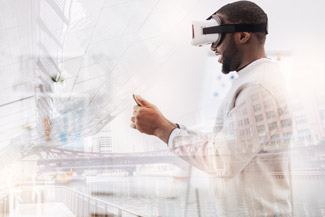Can virtual reality improve learning?
 Welcome to the virtual palace of memory. In this special place, you may meet Michael Jackson, Napoleon Bonaparte, Donald Duck or even Martin Luther King Jr. There are two ways to visit: on a computer screen where you move around using your mouse; or using a virtual reality headset where you are completely immersed in the environment. And if at the end of the visit, we asked you to remember where you had seen the different characters, in which one of these visiting modes do you think you would remember best?
Welcome to the virtual palace of memory. In this special place, you may meet Michael Jackson, Napoleon Bonaparte, Donald Duck or even Martin Luther King Jr. There are two ways to visit: on a computer screen where you move around using your mouse; or using a virtual reality headset where you are completely immersed in the environment. And if at the end of the visit, we asked you to remember where you had seen the different characters, in which one of these visiting modes do you think you would remember best?Virtual reality is a computer technology that allows users to physically dive into an artificial environment that reproduces sensory experiences, including sight, sound, touch and even smell. This technology is largely used in games, but a number of studies have shown its interest in the fields of education, training, and cognitive remediation. Researchers at the University of Maryland recently wanted to determine if people learned better in a virtual and immersive environment compared to more traditional media, such as a desktop computer.
For their study, the scientific team used the "memory palace” format. The palace is a mnemonic method used since Antiquity which consists of using well-known places (that we’ve visited several times) to memorize objects or people by association. This mnemonic encoding technique simply uses our brain's ability to spatially organize our thoughts and memories. 40 participants (mostly students from the University of Maryland) were familiarized with a series of well-known faces, such as Steve Jobs, Mona Lisa, Shrek, Arnold Schwarzenegger and Albert Einstein. The researcher then used the memory palace to show the subjects the different faces. Two imaginary places were used: a room inside a castle and an exterior view of a medieval town. For the experiment, two groups were defined (20 participants in each). In the first, the subjects first explored each of the places for 5 minutes in "virtual reality" mode (using the headset), and then in front of a computer screen using the mouse to modify their viewpoint (same visit length). In the second group, the order of the visit was reversed.
For each visit mode, Krokos, the study’s main author, and his colleagues told participants to memorize the location of each of the faces, half of which were in the castle and the other outside. After a short break of 2 minutes, each of the scenes reappeared with numbers in place of the faces. Each participant then had to find which face belonged at which numbered location. Which group performed better?
The results showed an overall improvement of 8.8% in recall accuracy in the virtual visit mode. In addition, the vast majority of participants said they preferred the immersive environment for memorization. Thanks to virtual reality, participants were able to more easily identify each face by its physical location. According to Krokos, “By visually navigating the scene, users could determine that 'Hillary Clinton is in the top left window and it looks like she is about 20 yards from where I am sitting.”
This research thus shows that relying on an immersive virtual environment may be beneficial for certain types of learning.
Source: Eric Krokos, Catherine Plaisant, Amitabh Varshney, Virtual memory palaces: immersion aids recall, in Réalité virtuelle , May 2018







